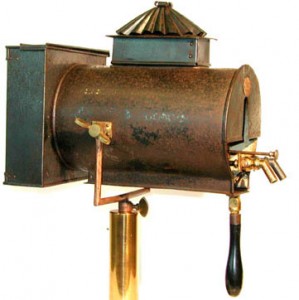Tuesday Twitter Trivia Winner – Limelight
 This weeks Tuesday Twitter Trivia took us back in time once again to see where the industry came from. So a quick recap from yesterday with the trivia question:
This weeks Tuesday Twitter Trivia took us back in time once again to see where the industry came from. So a quick recap from yesterday with the trivia question:
What is a Limelight and how does it work?
So what is a Limelight?
A Limelight is a type of stage lighting once used in theatres and music halls. An intense illumination is created when an oxyhydrogen flame is directed at a cylinder of quick lime (calcium oxide), which can be raised to 2572°C before melting. The light is produced by a combination of incandescence and candoluminescence. Although it has long since been replaced by electric lighting, the term has nonetheless survived, as someone in the public eye is still said to be “in the limelight.”
How about some history of the Limelight.
The limelight effect was discovered in the 1820s by Goldsworthy Gurney, based on his work with the “oxy-hydrogen blowpipe,” credit for which is normally given to Robert Hare. In 1825, a Scottish engineer, Thomas Drummond (1797–1840), saw a demonstration of the effect by Michael Faraday and realized that the light would be useful for surveying. Drummond built a working version in 1826, and the light is sometimes known as the Drummond Light after him.
Limelight was first used in public in the Covent Garden Theatre in London in 1837 and enjoyed widespread use in theatres around the world in the 1860s and 1870s. Limelights were employed to highlight solo performers in the same manner as modern followspots. Limelight was replaced by electric arc lighting in the late 19th century.
So who had the correct answer in yesterday via twitter. With the 140 character limit, Mr. Josh Allen or @JoshAllen was first in with an mention reply rather then than a direct message and wins a iSquint Prize Pack. Thanks for playing, look for more Tuesday Twitter Trivia next week and beyond here on iSquint.
Have an idea for a Tuesday Twitter Trivia question that might stump us? Send me your ideas via the Contact Us page on iSquint.
Thanks Wikipedia for the history lesson!
LatestHeadlines
- Upgrading Your Toolbox: City Theatrical DMXcat-E and DMXcat Multi Function Test Tool
- Claypaky Bringing Back the Sexy to Par Cans with the Midi-B FX
- Ayrton Evolves the Cobra, the Cobra2 Developed for the US Market
- MA Lighting Intros grandMA3 onPC Fader Wing and DIN-Rail Nodes
- Live Events LEVL Up Fest: A Festival to Aid our Industry